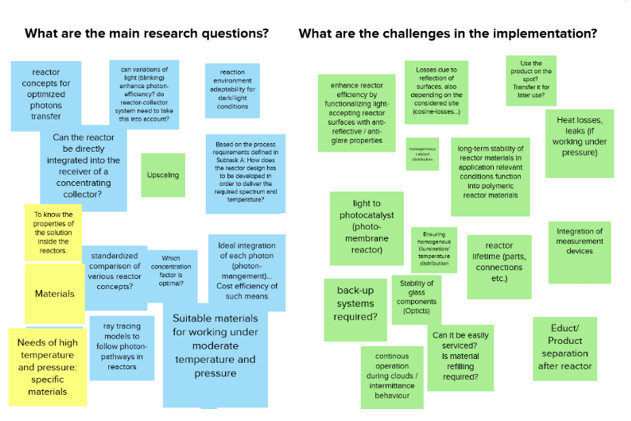Posted: February 25, 2024

Image: AEE INTEC
In future, a lot of green hydrogen will be needed in industry as an energy carrier. Currently, this green hydrogen is produced in electrolysers that are dependent on renewable electricity. But green power is also needed for many other applications. Sustainable alternatives to hydrogen production are therefore necessary. This is why scientists within the IEA Solar Heating and Cooling Programme have formed a group to investigate processes that make it possible to produce solar fuels by converting light energy into chemical energy in so-called solar reactors. The photo shows notes from the first brainstorming session of the research group to develop the framework for a three-year programme.
"At our first meeting in October 2023, there was a great deal of interest from universities and research institutes in working together on the topic of energy carriers from solar-powered reactors," reported Bettina Muster-Slawitsch, who initiated the research group. She heads the Water and Process Technology Group at the Austrian institute AEE INTEC. Representatives from 13 research institutions from Austria, Germany Portugal and Spain participated in the October meeting.
The group decided to work on the topic on all three levels: materials and component development, reactor design as well as system integration. Muster plans to hold the next preparation workshop on Tuesday 9 April in Graz, Austria, in the same week the International Sustainable Energy Conference ISEC takes place in Graz. For more information on this full-day meeting, please send an e-mail to Bettina Muster-Slawitsch: b.muster@aee.at. “We welcome all specialists from the fields of research and industry who want to be part of this expert exchange network on solar fuels to use sunlight for novel fuel production”, concluded Muster.

Exemplary design of a photo-reactor aligned with a solar collector for H2 production
Source: AEE INTEC
The research group is looking at two different processes. Photocatalysis is based solely on the driving force of photons to stimulate chemical processes (left). In photoelectrochemistry, electricity is applied in addition to photons of light to accelerate the process.
One exemplary reaction is the conversion of water (H2O) to hydrogen (H2) and oxygen (O2). "However, we also want to look at the production of other solar fuels in the IEA SHC work, not just hydrogen but also combinations with CO2 such as methane, methanol and ethanol," said Muster. Possible applications include the production of hydrogen from wastewater, methanol from CO2 or photoelectrochemical ammonia production.
Processes in which solar fuels are generated via solar tower plants are not being considered. Muster explains this decision as follows: "Processes that take place in solar towers are purely thermal energy driven. In the planned research group, however, we want to look at photo-reactors, which might include photo-thermal processes, but those in which photons definitely play a decisive role.”
In principle, such solar reactors are still at a low TRL level, said Sarah Meitz, a colleague of Muster at AEE INTEC. She listed the numerous aspects that need further R&D efforts to develop solar reactors:
- Catalysts are to be developed that make it possible to utilize photons with wavelengths of visible light.
- Operating parameters such as pH value or temperatures must be optimized
- Methods of concentrating the irradiation must be developed in order to increase the light intensity
- Reactor design must be adapted in a way that optimizes mass and energy transfer.
Muster plans to introduce a workplan for the three-year research platform to the executive committee of the IEA SHC in June 2024. If the task is approved, it can start in autumn 2024 as planned.
Websites of organizations mentioned in this news article: